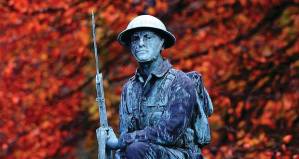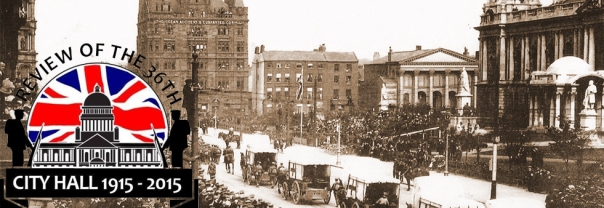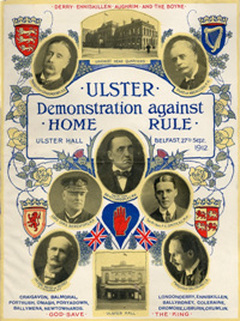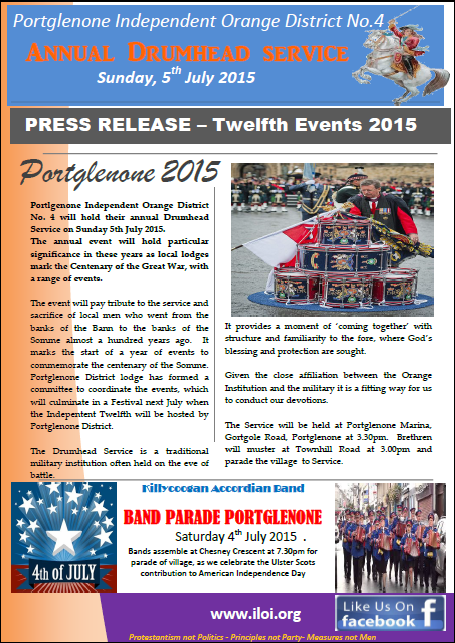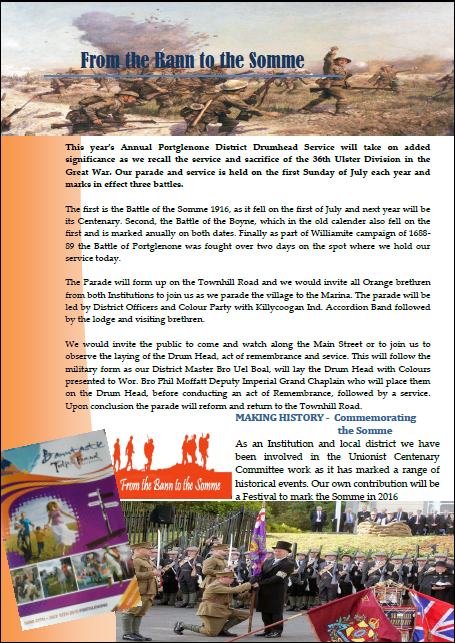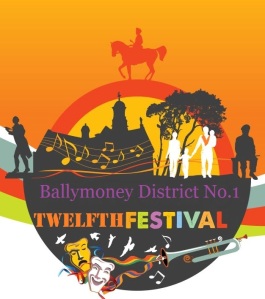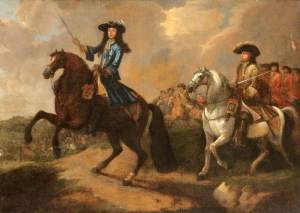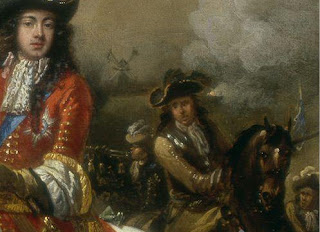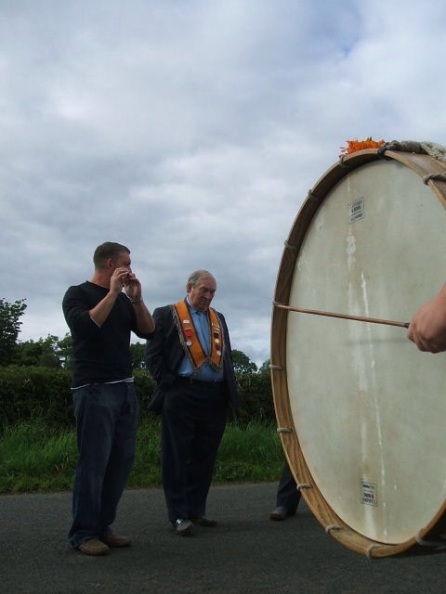Author Archives: mcneillstownilol46
Rev. DD Boyle
Rev David Dorrington Boyle DD
He is regarded as a founder member and clearly a leading light amongst Independent Orangemen, and had it not been for his intervention in Ballymoney it is questionable if the Institution would have taken the numbers it did.

As grand Chaplain he held the highest of offices however by 1908 he appears to have no real connection with the Order. He moved to Newry then east Belfast and served as minister there from 1910 until his death in 1938. Here under Boyle, McQuiston memorial Presbyterian Church eventually became the largest Presbyterian congregation in Ireland, peaking at over 1500 families.
Imperial Grand Lodge Meeting
The officers and members of the Independent Loyal Orange Institution held their annual meeting in the Headquarters Hall Ballymoney on Saturday 9th January 2016 at 2.00pm. The chair was taken by Rt Wor Bro Alan McLean Imperial Grand Master assisted in the Deputy chair by Wor Bro James Anderson . The Lodge was opened, normal business conducted and reports taken.

IGM Wor Bro McLean then thanked the brethren for having him as the IGM for the past five years,something that he enjoyed immensely and intimated that he was not standing for election for a further term. He then Called on Bro Victor McLean PCGM to conduct the election of officers.
 The main officers elected being, Imperial Grand Master Rt Wor Bro James Anderson, Deputy Grand Master Wor Bro Mervyn Storey MLA, Chaplain Wor Bro Derek McFarland,Secretary Wor Bro Alexander McFarland and Treasurer Wor Bro Roy Wilson. Following the election Wor Bro Cyril Glass PIGM IGL nstalled the newly elected officers.
The main officers elected being, Imperial Grand Master Rt Wor Bro James Anderson, Deputy Grand Master Wor Bro Mervyn Storey MLA, Chaplain Wor Bro Derek McFarland,Secretary Wor Bro Alexander McFarland and Treasurer Wor Bro Roy Wilson. Following the election Wor Bro Cyril Glass PIGM IGL nstalled the newly elected officers.
Members of McNeillstown ILOL N046 brought fraternal greetings and best wished from the lodge. We would like to pay tribute to the outgoing IGM Alan McClean for his leadership and dedication. It is a hard job heading up an Institution and he is to be commended for the progress and success his tenure in office saw.
Final Business was then conducted and the meeting closed with all retiring to the bottom hall where supper was served. Following supper Rt Wor Bro Anderson spoke briefly thanking those who has supplied and served an excellent supper.
Portglenone Drumhead Service
Portlgenone Independent Orange District No. 4 will hold their annual Drumhead Service on Sunday 5th July 2015. The annual event will hold particular significance in these years as local lodges mark the Centenary of the Great War, with a range of events.
The event will pay tribute to the service and sacrifice of local men who went from the banks of the Bann to the banks of the Somme almost a hundred years ago. It forms the start of a year of events to mark the centenary of the Somme. The local District lodge has formed a committee to coordinate the events, which will culminate in a Festival next July when the Indepentent Twelfth will be hosted by Portglenone District.
The Drumhead Service is a traditional military institution often held on the eve of battle. It provides a moment of ‘coming together’ with structure and familiarity to the fore, where God’s blessing and protection are sought. Given the close affiliation between the Orange Institution and the military it is a fitting way for us to conduct our devotions.
The Service will be held at Partglenone Marina, Gortgole Road, Portglenone at 3.30pm. Brethren will muster at Townhill Road at 3.00pm and parade the village to Service.
This year’s Annual Portglenone District Drumhead Service will take on added significance as we recall the service and sacrifice of the 36th Ulster Division in the Great War. Our parade and service is held on the first Sunday of July each year and marks in effect three battles.
The first is the Battle of the Somme 1916, as it fell on the first of July and next year will be the Centenary. Second the Battle of the Boyne, which in the old calender also fell on the first and is marked anually on both dates. Finally as part of Williamite campaign of 1688-89 the Battle of Portglenone was fought over two days on the spot where we hold our service today.
The Parade will form up on the Townhill Road and we would inbite all Orange brethern from both Institutions to join us as we parade the village to the Marina. The parade will be led by District Officers and Colour Party with Killycoogan Ind. Accordian Band followed by the lodge and visiting brethern.
We would invite the public to come and watch along the Main Street or to join us to watch the laying of the Drum Head and our sevice, and act of remembrance. This will follow the military form as our District Master Bro Uel Boal, will lay the Drum Head with Colours presented to Wor. Bro Phil Moffatt Deputy Imperial Grand Chaplain who will place them on the Drum Head, before conducting an act of Remembrance, followed by a service. Upon conclusion the parade will reform and return to the Townhill Road.
Snapshot from History
At this time the men of the 36th Ulster Division moved to Seaford on the Sussex coast of England. Lord Kitchener inspected the Division there on 27 July 1915, and later remarked to Carson “your Division of Ulstermen is the finest I have yet seen”. Another inspection took place, by King George V, on 30 September.
3-6 October: the Division moved to France, although the artillery remained in England until November.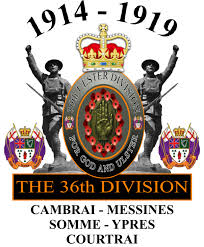
The Ulster Division initially concentrated in the area around Flesselles, some ten miles north of Arras. Gradually, men were sent in groups for familiarisation with trench warfare conditions, and were attached to the regular army 4th Division for the purpose in the (at this time) quiet are north of the River Ancre near Albert.
On 21 October the Division was moved away from the fighting area towards Abbeville, where it spent most of the winter of 1915-16 continuing training. One of the Brigades was attached to 4th Division for several weeks at this time and the artillery finally rejoined.
Come and Join us as we mark this historic event.
Ballymoney Twelfth Festival
We are looking forward to the Twelfth Festival in Ballymoney in the run up to the twelfth of July, so come join us for a range of events. From history to culture, parades to parties the week has it all. beginning on Monday with a historical bus tour and ending with the big day itself!
Faith will be at the heart of all we do and this year to mark the Institutions association with St Jame’s Presbyterian church we will be having a Twelfth morning service there.
We will keep you posted on the events as they happen.
Imperial Grand Lodge Church Service
To mark this connection on Monday 13th July there will be an Imperial Grand Lodge Church Service in Boyle’s old church – St James’s Presbyterian Church at 11.00am followed by annual Demonstration in Megaw Park, parade to leave Park at 1.00pm for parade of Town followed by platform proceedings, Chair to be taken at 2.30pm. Return Parade will leave Park at approximately 4.15pm for parade Coleraine Road, High St and Main St terminating at Seymour Street.
Twelfth 2015
As the Twelfth approaches we are preparing for our Big day, as we mark the annual Boyne celebrations in style.
Like all lodges across the country these weeks are a busy time for us. The Twelfth and all that people see that day does not simply happen, it takes time and money and dedication to bring it all together. As a drumming lodge we have to spend time preparing or ‘pulling’ the drums to ensure there are tight and just right for the big day. Even after weeks of preparation if the rain comes it will all be for nothing, but at least we know they would have sounded well !
The hall itself gets a facelift in time for the big day and the hedges cut and yard tidied, its times like this we envy our brethren in the towns! For smaller lodges the same work has to be done only with less hands and we would appeal for volunteers and helpers to come join us as this is a time for community and cooperation.
This year we will have our Twelfth in Ballymoney and if you would like to join us either visiting brethren from the mainland to walk or families and friends to spectate then drop us a message on here and we will provide details. It promises to be a great day for all and a warm welcome awaits in Ballymoney the home of the Independents.
The week running up to the Twelfth promises to be a fun time for all the family with the Twelfth Festival planned by Ballymoney District. There will be a full programme from historical bus tours to an Ulster Scots Ceidilh featuring local artists, poets and much more, in the ILOL Hall Edward St. Ballymoney.
As a lodge we will be meeting at the Hall then proceeding to Ballymoney for a church service before the main Twelfth Parade.
The Demonstration and Platform Party will be in Megaw Park followed by a return Parade of the town.
So why not plan to join us bring your family and friends and make this your big day too!
District Meeting
 Tonight the lodge attended the meeting of Portglenone Independent Loyal Orange District Lodge No. 4, in our neighboring hall Killcoogan. It was a great meeting with plans in place for a range of events this years and even next.
Tonight the lodge attended the meeting of Portglenone Independent Loyal Orange District Lodge No. 4, in our neighboring hall Killcoogan. It was a great meeting with plans in place for a range of events this years and even next.
There was a presentation of a framed certificate to mark the District’s participation in a parade of banners which marked the centenary of the signing of the Covenant. The event was a world record for the number of banners on parade, with the District bannerette proudly on display.
 Other events to commemorate the Centenary of the Home Rule period were discussed and planned with the next in May this year. Our own Somme preparations are under way for 2016 as we host the Twelfth that year.
Other events to commemorate the Centenary of the Home Rule period were discussed and planned with the next in May this year. Our own Somme preparations are under way for 2016 as we host the Twelfth that year.
We are running a bus to the parade in Belfast on 9th May and hope to see many members on parade as we mark this historic event.
March Past Belfast City Hall
36th Ulster Division march past Belfast City Hall on the 8th May 1915 before heading to England for training and then on to the battle fields of Europe.
In 1915, the Division moved to Seaford, on the Sussex coast of England. This was the first time that many of the men had been outside their native Ireland. Kitchener inspected the Division there on 27 July 1915, and later remarked to Carson “your Division of Ulstermen is the finest I have yet seen”
In October 1915 after several months of preparation in England, men of the 36th Ulster Division sailed across the Channel and began to disembark in France. The soldiers, drawn from all parts of the nine counties of Ulster, had previously trained at Finner Camp in Donegal, Ballykinlar in County Down, and the Clandeboye Estate near Bangor. All were volunteers with an overwhelming majority of them in their late teens and early twenties and, while many perhaps sought adventure and a chance to see some of the world beyond the confines of their own home towns and villages, they believed absolutely that their cause in going to war to free France and Belgium from German oppression and invasion was just and honourable.

Most of the battalions and other divisional units travelled to Belfast on the day preceding the parade. On the morning of the parade the men of 108th Brigade, including the 9th Royal Irish Fusiliers, travelled by eight trains from Newtownards and Bangor; the last train arrived in Belfast at a little after 8.00am.
 The entire Division, numbering nearly 17,000 men, formed up at Malone with 107th Brigade on the right. Beside it were the men of the Divisional Troops—Royal Engineer Field Companies and the Divisional Signal Company, the Cavalry Squadron and Cyclist Company and the men of the Field Ambulances and the Army Service Corps. Next was 108th Brigade and then 109th Brigade on the left, nearest the Malone Road. The Division was inspected by the well respected officer and former MP for North Antrim, Major General Sir Hugh McCalmont KCB, CVO. After the review, the Ulster Division marched through the city centre.
The entire Division, numbering nearly 17,000 men, formed up at Malone with 107th Brigade on the right. Beside it were the men of the Divisional Troops—Royal Engineer Field Companies and the Divisional Signal Company, the Cavalry Squadron and Cyclist Company and the men of the Field Ambulances and the Army Service Corps. Next was 108th Brigade and then 109th Brigade on the left, nearest the Malone Road. The Division was inspected by the well respected officer and former MP for North Antrim, Major General Sir Hugh McCalmont KCB, CVO. After the review, the Ulster Division marched through the city centre.
Along the route the streets were decked out with bunting and flags and crowded with local people and the family and friends of those on parade. During the march past at City Hall, which lasted for over one and a half hours, the salute was taken by the General alongside the Mayor. The parade was attended by Sir Edward Carson, who had travelled from London to see it. By 9.00pm 108th Brigade was back at Clandeboye having returned by eight trains to Bangor and Newtownards.
Burns night
The annual celebratory tribute to the life, works and spirit of the great Scottish poet, Robert Burns (1759-1796).
Celebrated on, or about, the Bard’s birthday, January 25th, Burns Suppers range from stentoriously formal gatherings of esthetes and scholars to fun family evenings. Most Burns Suppers include the traditional haggis, nips and tatoos with music, poetry and other activities in the spirit of the Bard.
Here is a typical run through and description of what is involved in a Burns Supper:
Piping in the top table
At formal gatherings, it is traditional for the top table guests to be piped in. However, at a smaller and less formal gathering, you can play some Scottish music, traditional bagpipe music or your favourite contemporary Scottish band, and clap along to welcome your guests.
Welcome
The selected Chairman or Speaker acts as Master of Ceremonies for the evening and welcomes the guests – the host of an informal evening usually takes this role. The Chairman introduces the top table and any other speakers and entertainers before reciting the Selkirk Grace:
‘Some hae meat and canna eat, And some would eat that want it, But we hae meat, and we can eat, Sae let the Lord be thankit’.
Piping in the haggis
The haggis is the crowning glory of a Burns Supper and, suitably, is piped in to an upstanding audience. Traditionally the chef carries the haggis in on a silver platter behind the piper and is followed by the person who will address the haggis.
The address to the haggis
The appointed speaker gives a dramatic rendition of Burns’ Address to a Haggis with a knife at the ready. After apologising for ‘killing’ the haggis, they then plunge the knife into the haggis and slice it open during the line ‘An’ cut you up wi’ ready slight’’ meaning ‘and cut you up with skill’. The recital ends with the platter being raised above their head whilst saying the triumphant words ‘Gie her a Haggis!’ to rapturous applause.
Toast to the haggis
The speaker then invites the guests to toast the haggis and everyone, including the chef, raises their glasses and shouts ‘The Haggis’ before enjoying a dram. The haggis is then piped back out to be prepared for dinner.
The meal
Spicy haggis, meat or vegetarian, is traditionally served with buttery mashed neeps and tatties and sometimes a whisky cream sauce.
First entertainer
The Chairman introduces the first entertainer who then performs one of Burns’ songs or poems such as A Red, Red Rose or Tam O’ Shanter.
The immortal memory
The main speaker is introduced and gives an enthralling account of Burns’ life. His literary prowess, politics, nationalistic pride in Scotland, faults and humour should all be explored to give the audience an insight into Burns’ life and works in a witty, yet serious way. The speaker concludes with an invitation to join in a heart-felt toast: ‘To the Immortal Memory of Robert Burns’.
Second entertainer
More celebration of Burns with singing or a recital.
Toast to the lassies
A humorous speech written for the evening that gently ridicules the (few) shortcomings of women that aims to amuse both sides of the audience – ‘observations’ therefore should not be too cutting! Despite the initial mockery, the speech ends on a positive note with the speaker asking the men to raise their glasses in a toast ‘to the lassies’.
Third entertainer
More songs, recitals and music.
Reply to the toast to the lassies
The chance for a female speaker to retort with some good-natured jokes of her own, beginning with a sarcastic thanks on behalf of the women present for the previous speaker’s ‘kind’ words, before giving a lively response highlighting the foibles of the male race, using reference to Burns and the women in his life. Again, this speech finishes on a positive note.
Final entertainer
The last entertainer bravely faces a merry crowd for some final songs and readings.
Vote of thanks
A vote of thanks is made to everyone who has made the evening such a roaring success, from the chef and speakers to the guests.
Auld Sang Syne
A Burns Supper traditionally ends with the singing of Burns’ famous song about parting, Auld Lang Syne. Everyone joins hands in a large circle and sings the words together and at the line ‘And here’s a hand’, you cross each of your hands over to rejoin those standing on either side of you.
Just a quick review of how the site is going, we are still in trial phase with a free site but in couple of months figures are looking good thankyou to all our friends a d users !
The WordPress.com stats helper monkeys prepared a 2014 annual report for this blog.
Here’s an excerpt:
A San Francisco cable car holds 60 people. This blog was viewed about 670 times in 2014. If it were a cable car, it would take about 11 trips to carry that many people.
Ulster’s Forgotten Heros – the Ulster Defense Regiment
Ex-UDR man recalls gun battle with IRA gang
A FORMER UDR soldier who turned an IRA ambush into one of the regiment’s finest hours has shared his remarkable story for the first time.
Fermanagh man Eric Glass is the most highly decorated soldier in the proud history of the regiment.
Former council dog warden by day — Corporal Glass of 4 UDR by night, this affable family man looks an unlikely hero sitting in the living room of his house in Ulster’s picturesque Lakelands, but his fighting spirit is without question.
Having been shot in the shoulder during a failed attempt on his life in 1978, Eric could have been forgiven for going underground and beginning a safer new life elsewhere.
However, with the unwavering support of his exceptional family, not for one minute did he contemplate leaving his beloved Fermanagh or being intimidated out of his job with the council.
Defying countless terrorist threats, Eric continued with his daily routines at home and work until the IRA raised the stakes significantly on a winter morning in 1992.
In a rare interview, last week Eric told the News Letter how he faced his greatest challenge and still bears the scars — both physical and mental.
As Eric explained, he was taking his morning tea break when his secretary took a telephone call giving directions to the scene of an alleged dog attack.
“I asked her if the call was for me and she said it was so I spoke to him,” Eric said.
The voice belonged to an IRA gunman — one of a four-man gang staging a carefully planned ambush at a border farmhouse near Belleek.
“He didn’t sound nervous or anything. He just said his niece was down at the weekend and the wee dog had bit her on the face.
“Then he said ‘I don’t know what to do about it’ and kept asking me what time I would be down.”
The heavily armed gunmen had been in the house from the morning before, keeping the householder hostage.
“As I drove down the lane to the house I had my gun [a Walther pistol] under a coat on the front seat,” Eric recalled.
“The minute I pulled up one guy came to the driver’s door — he had a gun [an automatic rifle] with binder twine on it slung round his neck — and the other one had a revolver. They came running out shouting and swearing ‘get out of the van — IRA’.
“The one with the revolver ran up to the passenger door.
“I cocked the gun and fired three shots out through the passenger side,” Eric said. The body of Joe MacManus, 21, from Sligo was later recovered from the scene.
“I swung round quick and pushed the door into the other guy. He had the rifle round his neck on the string and was going to use his hands to get me out of the van but he ran off.”
Eric took cover behind the front wheel of the van and opened fire on two further gunmen armed with Kalashnikov-type rifles behind a low wall no more than 20 metres away.
When one moved position and appeared at the side of the house, Eric took careful aim and pulled the trigger only to find he was out of ammunition.
“The magazine was empty but I had another one in my coat which was in the van.”
Eric would have to place himself in direct line of fire, running back around the open van door to retrieve his spare magazine. “I pulled out the coat, got the full mag and whacked it in to the gun.”
When the terrorists realised what was happening they closed in for the kill as Eric explained: “They ran down firing on automatic and that’s when I got the whacked on the legs.” Eric’s left leg had shattered below the knee and he was losing a lot of blood.
“With the new magazine on I fired back and somebody roared ‘two, three and four run for it’ and they disappeared into cover.
“When I shouted at the man in the house to phone for help he said he couldn’t as the boys would come back and shoot him.”
Worried he could lose consciousness before help was summoned, Eric hauled himself up on a brush shaft and made it to the phone in the hallway of the farmhouse.
“After I made the phone call [to the police] I looked out the window and saw one of them coming back up again. He went up to the boy that was shot and took his pistol.
“This was all happening maybe five or even ten minutes after it all started.
“I had only two or three rounds left at this stage and I remember thinking: ‘If he comes in for me now I’ll just lie here and let him shoot away at me.’ The adrenaline had all left the body and I couldn’t have cared less. I could see all the blood pouring out of my boots.”
The crew of a military helicopter coming to Eric’s assistance spotted the three remaining gunmen who were still at the scene.
They fled towards the border but were picked up by Garda officers and arrested.
At their subsequent trial in Dublin, Eric spent almost four full days in the witness box under cross-examination.
All three were eventually convicted and jailed for their role in the shooting.
Corporal Glass was awarded the Distinguished Conduct Medal — second only to the Victoria Cross — for his actions in the face of the enemy.
He was the only soldier to receive such a high honour in the 22-year-history of the Regiment.
His bravery earned him the respect and admiration of everyone connected with the UDR but, although thankful to be alive, he paid a high price for his heroism on that fateful day.
“I spent nine months in hospital because the bones in my left leg were shattered. Then when I eventually got our of hospital I found I didn’t have a job to go back to with the council. That was hard to come to terms with after all those years working there,” Eric explained.
Still reeling from the loss of his day job, the former dog warden was then paid a visit by representatives of the UDR’s personnel department.
Eric said he was “gutted” at the suggestion he would be better off leaving the Regiment.
“It took a lot out of me that day because I didn’t for one minute think I would have to leave the UDR. They were very good about it, and sympathetic OK, but it wasn’t nice to hear.
“In the end they explained everything about pensions and things like that and eventually convinced me it would be for the best.”
Welcome relief from the thought of enforced unemployment came in the form of a private audience with the Queen.
As Eric views his family as the real heroes of the story, he was delighted to have his wife with him at Buckingham Palace in 1993 for the Distinguished Conduct Medal presentation.
“We were the only two there and the Queen just chatted to us like a normal person. She asked me were we still living in the same house and then she turned to my wife and asked her how she dealt with it all.”
Despite leaving the Regiment in 1993, Eric remained a prime terrorist target and subsequently moved house to minimise the risk.
When the remaining members of the IRA gang were released from prison under the Good Friday Agreement, the police again visited the Glass family home to advise them of the need to review their personal security.
Despite his iconic status in the Regiment’s history, Eric says with typical humility, “I was fighting for my life.”
“I just happened to be an ordinary person called on to do something extraordinary at the time, but I worked with a lot of very brave men and women.”


